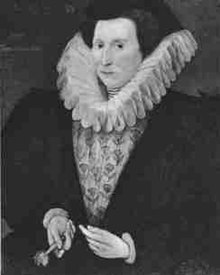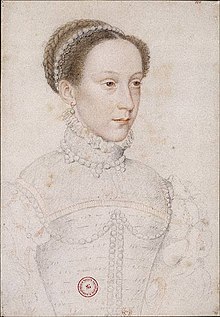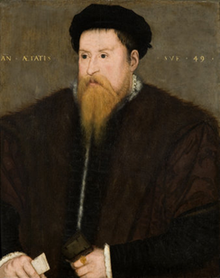Nicholas Throckmorton
Sir Nicholas Throckmorton (or Throgmorton) (* 1515 or 1516 - † February 12, 1571 in London ) was an English agent , diplomat and politician . He is considered the gray eminence behind several conspiracies and conspiracies during the reign of Edward VI. , Maria I and Elizabeth I , however, were never clearly found guilty. Under Elisabeth he often acted as a messenger between her and her rival Maria Stuart . He fell from grace in 1569 because of his role in a Thomas Howard, 4th Duke of Norfolk conspiracy against Queen Elizabeth. He is the father of Elizabeth Throckmorton , the Queen's preferred lady-in-waiting and later wife of Sir Walter Raleigh .
Life
Early years
Nicholas was born the fourth son of Sir George Throckmorton (c.1489–1552) and his wife Katherine. Through his mother, he was a cousin of Queen Catherine Parr . His date of birth is derived from John Foxe's report that Throckmorton was 35 years old in January 1551, on the conviction of Bishop Stephan Gardiner . In his youth, he likely served Henry Fitzroy , the illegitimate son of King Henry VIII , along with his relative William Parr. When Fitzroy traveled to France with his father in 1532 and then stayed at the French court for a year, Throckmorton accompanied him and learned French during this time. The poem The Legend of Sir Nicholas Throckmorton was written about his life and about his time in France it says:
|
By parents' hest, I served as a page |
At parental orders, I served as Page |
After Fitzroy's death, he entered the service of the Parrs, his relatives, and served on the Scottish border in 1543. When his cousin Catherine married the king, Throckmorton received a position at court. In Henry's War against France in 1544, he was part of the army that Boulogne captured for England, although the victory was short-lived. Like Catherine Parr, Throckmorton was a Protestant at court. He visited u. a. Anne Askew, sentenced as a heretic in prison, was an eyewitness to her execution. In 1545 he was elected to the lower house of parliament for the first time , possibly thanks to the influence of Catherine Parr. Until 1567 he remained a member of the lower house for five different constituencies.
Under Edward VI.
After the death of Henry VIII in 1547, Nicholas took a job in the household of his cousin. There he befriended her new husband Thomas Seymour and became confidante of the young Elisabeth Tudor , who had lived with Catherine since the death of her father. Through his Protestant sympathies, Throckmorton also became a favorite of the young King Edward VI. In 1547 he took part in the successful campaign against the Scots at the Battle of Pinkie Cleugh . Throckmorton survived the case of Thomas Seymours and later his brother Edward Seymours unscathed, as he distanced himself from both in good time and possibly made contacts with John Dudley at an early stage .
Under the latter's protectorate, he became a gentleman of the royal private chambers in 1549 and thus had the task of dressing the young king and entertaining him. On top of that, he was given the lucrative office of Treasurer of the Mint , the treasurer who oversaw the royal mint. In the same year he married Anne Carew, daughter of Nicholas Carew and niece of Francis Bryan . In 1551 the king knighted him . In the same year he accompanied his cousin William Parr, Marquess of Northampton , to his embassy to France and after his return belonged to the escort of the Scottish Queen Marie de Guise during her visit to England. He also prepared the young king more and more for his government business. He is often held responsible for the fact that William Thomas, a humanist scholar, prepared documents for Eduard in which political discussions were held.
When the king's health deteriorated, Dudley tried to prevent the succession of the Catholic Maria Tudor . To this end, he married his son Guildford Dudley to the Protestant Lady Jane Gray , a granddaughter of Henry's younger sister Mary Tudor . Possibly on Dudley's advice, Eduard changed the line of succession on his deathbed and named Jane Gray as his successor. The Regency Council accepted the change of line to the throne and Throckmorton, who assisted the king in his final months, also signed the document. Edward VI died on July 6, 1553. Dudley hid the king's death and tried to arrest Maria Tudor. Though Dudley trusted Throckmorton enough to allow him to have twenty-five armed servants (English: retainers ), Throckmorton secretly sent and warned Maria of Edward's death. Thus Maria was able to flee to the Catholic Howards in Norfolk in time . As so often in his life, Throckmorton did not position himself too clearly, for his wife Anne Carew served Jane Gray until the end of her brief reign.
Under Maria I.
After just nine days, Maria was able to assert her claim to power and was proclaimed queen. However, according to some reports, Throckmorton tried to prevent Maria's proclamation in Northampton, which was seen as support for Jane Gray. If it did, Maria ignored the incident, as Throckmorton retained his offices and put together an escort for the new queen on July 24th. In order to prevent a renewed Protestant succession to the throne by her half-sister Elisabeth, Maria looked for a Catholic husband. Her choice fell on the Spanish Crown Prince Philip. This met with great rejection from the English. Throckmorton too went into open opposition to the Queen's plans to reintroduce Catholicism. His name appeared on a list of those who “represent the true religion”. However, there is no evidence that he ever spoke out openly against Maria's marriage plans.
As Maria stuck to her choice, revolts broke out, culminating in the Wyatt conspiracy . The royal army only defeated Thomas Wyatt's troops at the gates of London and the uprising was put down. Throckmorton, Jane Grey's father Henry Gray, 1st Duke of Suffolk and also Elizabeth were brought into the Tower as co-conspirators. Throckmorton was charged as a traitor and had to testify in the Guildhall . Nevertheless, he was able to convince the jury of his innocence, an almost unheard of incident, since traitor tribunals usually served to make the world the guilt of the accused clear. The Privy Council was so angry with the verdict that the jury was incarcerated for the rest of the year. He was released from the Tower in January 1555 after long imprisonment.
When the Dudley conspiracy was exposed in December 1555, Throckmorton was again suspected of complicity. Fearing re-imprisonment and trial, he fled into exile in France in June 1556 , which resulted in the confiscation of all of his property. Nevertheless, he protested his innocence and Maria finally believed him. She allowed his wife Anne Carew to provide him with money and allowed him to return to England in May 1557. He got his lands back and served with Robert Dudley, 1st Earl of Leicester in the English army in the war against France that summer. Towards the end of Mary's reign, Throckmorton increasingly contacted her sister Elisabeth.
Under Elizabeth I.
Ambassador to France
Under Elisabeth Throckmorton received several diplomatic assignments, including a. to France. There he was an eyewitness on June 30, 1559 of the tournament in which the French King Henry II was fatally injured. His son Franz II succeeded him on the throne, the husband of the young Maria Stuart . Throckmorton expressed his concern to Elisabeth that Maria's uncles from the House of Guise would exert too much influence on the young royal couple. His fears came true when a rebellion broke out against the Guises in 1560, which was bloodily suppressed by them, even for the terms of the time. According to Throckmorton, who witnessed the mass executions that followed, "eighteen of the bravest captains in all of France were among those captured."
Nevertheless, he showed a keen sense of the mood in France and the political direction. He warned the English court urgently against the "dishonorable and naughty reports that are being given here about our Queen" when rumors about Elisabeth and her favorite Robert Dudley were circulating in France. In particular, when Dudley's wife Amy died under mysterious circumstances, Throckmorton had a hard time at the French court. “One laughs at us, the other makes threats, another insults the queen. Some even say what kind of religion it is where a subject kills his wife and the princess not only allows it, but also marries him? ”It was particularly annoying for him that Mary had the English coat of arms in addition to the French and Scottish coats of arms led. After the death of Francis II, he also quickly realized that Maria was considering marrying his younger brother in order to remain Queen of France. He attended the coronation of King Charles IX. part.
During his time in France he regularly tried to get Mary Queen of Scots to ratify the Treaty of Edinburgh , in which Scotland recognized Elizabeth as the rightful queen, but Mary refused to keep her own claim to the English throne. William Cecil warned Throckmorton that he had discovered a secret plan to bring Mary to the throne if Elizabeth should not give birth to an heir. Despite everything, Throckmorton was full of admiration for Maria. “Her wisdom and royal modesty are so great that she does not consider herself wise, but is content to be guided by good advice and wise men (which is a great virtue for every prince and princess, and which is a great power of judgment and proves wisdom in it) ”. Historians conclude from his letters that he compared the two queens and that Maria fared significantly better.
After Maria left for Scotland, Throckmorton befriended the young Edward Seymour , who had been sent to the French court by Elizabeth. When the latter fell from grace because of his forbidden marriage to Lady Catherine Gray , Throckmorton tried to placate the angry Queen by assuring her that Seymour's "good behavior here has brought her great honor and good service". In 1562, Throckmorton got caught between the fronts of the English and French once more when religious unrest in France led to massacres of Protestants. He was captured by the de Guises, his servants wounded and his home destroyed. There were also conflicts because he did not want to kneel in front of the host, which angered the French. As early as 1561 he had asked the Queen's permission to return to England, which he was only allowed to do in 1564.
Later years
On his return to England, Throckmorton received the offices of Treasurer ( Chamberlain of the Exchequer ) and Cupbearer ( Chief Butler of England ) as a reward for his services . He regularly delivered messages to Mary Queen of Scots in Scotland when she decided to marry Henry Stuart, Lord Darnley , and thus saw firsthand how upset the Scottish nobility were about the marriage. He himself was stunned by the change that had happened to the Queen, whom he once admired, and said that she was so foolish and boastful that at the moment she would not keep the slightest promise. For him, majesty and a tumultuous infatuation were incompatible.
When Mary was imprisoned at Loch Leven Castle in June 1567 as a result of the events following Darnley's murder , Elisabeth dispatched Throckmorton to support her against the Scottish nobles and to threaten them with war if they did not treat Mary as a queen should. He kept Elizabeth informed of what was happening in Scotland and possibly saved Mary's life by his mere presence; however, he was refused a visit to Mary in Lochleven. At the same time he was in contact with Cecil and Robert Dudley in order to persuade Elisabeth to name Maria Stuart's son Jakob as her successor. In September he was called back to England and lived a rather secluded life. In 1569, however, he was suspected of supporting Maria Stuart's secret engagement to Thomas Howard, 4th Duke of Norfolk . He was temporarily detained in Windsor and was under house arrest until the spring of 1570.
On February 8, 1571 he drew up his will, in which he named his wife Anne Carew as his executor and generously gave her and their children a generous treat. He also made preparations for his funeral, for which he wanted a Puritan clergyman, and bequeathed a sum of money to the Dutch Church in London. He died on February 12th in London. Contemporary reports that he was poisoned by Robert Dudley are likely to be false. He was buried in the Church of St Katharine Cree , where his tomb can still be seen. Of Throckmorton's death, Dudley wrote:
“On Monday we lost our good friend Sir Nicholas Throckmorton, who died in my house where he suddenly became seriously ill the previous Tuesday. His lungs were destroyed, but a sudden cold caused his unexpected death. God has his soul and we, his friends, are losing his body. "
progeny
Several children resulted from the marriage to Anne Carew:
- William Throckmorton (* 1554; † 1622), possibly mentally disabled
- Sir Arthur Throckmorton (* 1556; † 1626)
- Thomas Throckmorton (* 1557; † 1590)
- Robert Throckmorton (* 1558)
- Sir Nicholas Throckmorton († February 25, 1644), changed his surname to Carew as the general heir of his uncle Sir Francis Carew († May 16, 1611)
- Henry Throckmorton (* 1560)
- Anthony Throckmorton (* 1562)
- Elizabeth Throckmorton , called Bess (born April 16, 1565, † 1647), married to Sir Walter Raleigh
After Throckmorton's death, Anne Carew was second married to Adrian Stokes, widower of royal cousin Frances Brandon .
literature
- AL Rowse: Sir Nicholas Throckmorton, Part I . In: History Today . Vol. 12, No. 1, 1962, ISSN 0018-2753 , pp. 3-12.
- AL Rowse: Sir Nicholas Throckmorton, Part II . In: History Today . Vol. 12, No. 2, 1962, ISSN 0018-2753 , pp. 125-131.
Web links
- Sir Nicholas Throckmorton on thepeerage.com
Individual evidence
- ↑ a b c d e f g h i j k l m n o p q Stanford Lehmberg: Throckmorton, Sir Nicholas (1515 / 16–1571) . In: Oxford Dictionary of National Biography . 2004 Oxford University Press. Online version January 2008 , accessed June 8, 2011
- ↑ Jessie Childs: Henry VIII's Last Victim. The Life and Times of Henry Howard, Earl of Surrey. 2008 Vintage Books, p. 73
- ↑ Leanda de Lisle: The Sisters who would be Queen. The Tragedy of Mary, Katherine and Lady Jane Gray. 2008 Harper Press, p. 65
- ↑ Leanda de Lisle: The Sisters who would be Queen. The Tragedy of Mary, Katherine and Lady Jane Gray. 2008 Harper Press, p. 107
- ↑ Eric Ives : Lady Jane Gray. A Tudor Mystery. 2009 Wiley-Blackwell, p. 236
- ↑ Eric Ives: Lady Jane Gray. A Tudor Mystery. 2009 Wiley-Blackwell, p. 237
- ↑ Leanda de Lisle: The Sisters who would be Queen. The Tragedy of Mary, Katherine and Lady Jane Gray. 2008 Harper Press, p. 160
- ↑ Jane Dunn: Elizabeth and Mary. Cousins, Rivals, Queens. 2005 Vintage Books Edition, p. 120
- ^ Anna Whitelock: Mary Tudor. England's first queen. Bloomsbury 2010, p. 290
- ↑ Leanda de Lisle: The Sisters who would be Queen. The Tragedy of Mary, Katherine and Lady Jane Gray. 2008 Harper Press, p. 188
- ↑ Jane Dunn: Elizabeth and Mary. Cousins, Rivals, Queens. 2005 Vintage Books Edition, p. 136
- ↑ a b Jane Dunn: Elizabeth and Mary. Cousins, Rivals, Queens. 2005 Vintage Books Edition, p. 165
- ↑ Leanda de Lisle: The Sisters who would be Queen. The Tragedy of Mary, Katherine and Lady Jane Gray. 2008 Harper Press, p. 211
- ↑ Jane Dunn: Elizabeth and Mary. Cousins, Rivals, Queens. 2005 Vintage Books Edition, p. 179
- ↑ Jane Dunn: Elizabeth and Mary. Cousins, Rivals, Queens. 2005 Vintage Books Edition, p. 178
- ↑ Leanda de Lisle: The Sisters who would be Queen. The Tragedy of Mary, Katherine and Lady Jane Gray. 2008 Harper Press, p. 218
- ↑ Jane Dunn: Elizabeth and Mary. Cousins, Rivals, Queens. 2005 Vintage Books Edition, p. 239
- ↑ Jane Dunn: Elizabeth and Mary. Cousins, Rivals, Queens. 2005 Vintage Books Edition, p. 243
- ↑ Jane Dunn: Elizabeth and Mary. Cousins, Rivals, Queens. 2005 Vintage Books Edition, p. 313
- ↑ Calendar State Papers Scotland , vol. 2 (1900), p.363
- ↑ p20427.htm # i204270 on thepeerage.com , accessed August 18, 2015.
| personal data | |
|---|---|
| SURNAME | Throckmorton, Nicholas |
| ALTERNATIVE NAMES | Throgmorton, Sir Nicholas |
| BRIEF DESCRIPTION | English agent, diplomat and politician |
| DATE OF BIRTH | 1515 or 1516 |
| DATE OF DEATH | February 12, 1571 |
| Place of death | London |





